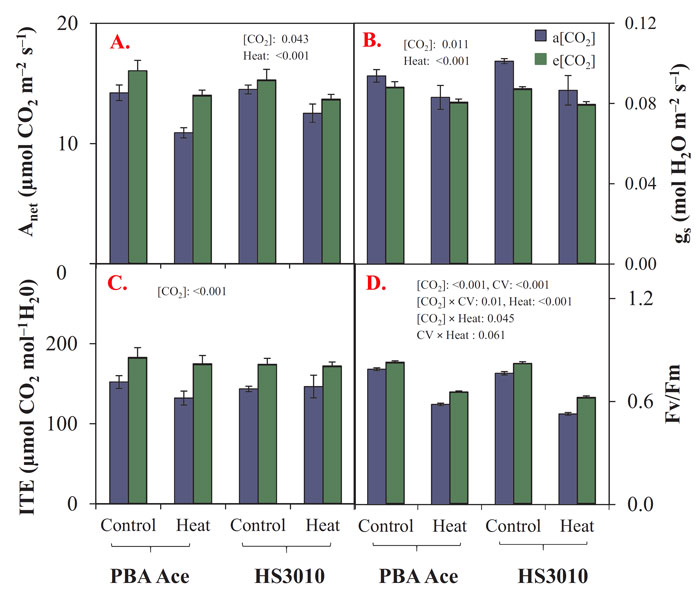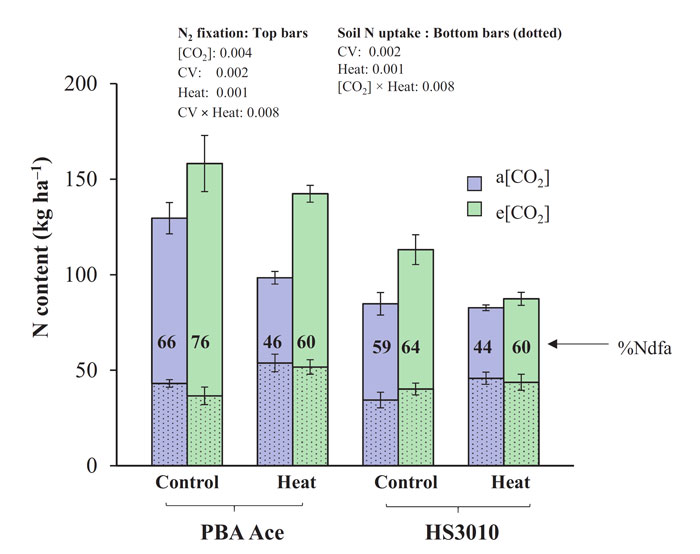| Tweet | Follow @co2science |
Paper Reviewed
Parvin, S., Uddin, S., Bourgault, M., Delahunty, A., Nuttall, J., Brand, J., O'Leary, G., Fitzgerald, G.J., Armstrong, R. and Tausz, M. 2019. Effect of heat wave on N2 fixation and N remobilization of lentil (Lens culinaris MEDIK) grown under free air CO2 enrichment in a Mediterranean-type environment. Plant Biology doi: 10.1111/plb.13047.
Introducing their work, Parvin et al. (2019) write that "the interaction between elevated CO2 and heat waves can alter nitrogen acquisition or remobilization patterns and thus may affect grain nitrogen yield and concentration." Consequently, they note that "identifying genotypes or traits that can maximize nitrogen fixation benefits under such conditions are therefore important." And thus they set out to examine "the mechanisms and to what extent elevated CO2 can mitigate the heat wave effects on N2 fixation and grain nitrogen concentration of lentil, and whether this response varies between genotypes."
The work was conducted at the Australian Grain Free Air CO2 Enrichment (AGFACE) facility near Horsham, Victoria, Australia, using two lentil cultivars (PBA Ace and HS3010). The plants were subjected to either ambient (400 ppm) or elevated levels of CO2 (550 ppm during daylight hours only) for the length of the growing season. At the flat pod stage (R4) a heat treatment was imposed on a subset of plant in each CO2 treatment for three days. Each day the heat treatment lasted from 0900 to 1600 hours and temperatures in the canopy were increased to 7 °C above ambient levels, reaching a target temperature of 40 °C.
The experiment produced the following key findings:
1. "Net assimilation rate (Anet) was higher in plants growing under elevated CO2 compared to ambient CO2" (Figure 1a).
2. Lentil cultivars grown at elevated CO2 had significantly lower stomatal conductance (gs) than those grown at ambient CO2 (Figure 1b).
3. Intrinsic transpiration efficiency (ITE) and the maximum quantum efficiency of PSII (Fv/Fm) were both increased by elevated CO2 (Figure 1c and 1d).
4. Elevated CO2 "increased N2 fixation of lentil by 30%" (Figure 2) and "the increased N2 fixation was associated with higher active/viable nodule biomass."
5. The heat wave treatment "decreased N2 fixation by 40%," which decrease was "associated with a larger proportion of dried, dead and senescent nodule biomass in heat-affected plants."
6. Elevated CO2 "helped maintain the formation and function of nodules, potentially because of increased water soluble carbohydrate (WSC) availability, which may buffer against the reduction in N2 fixation after heat wave events."
7. Elevated CO2-gorwn lentil exposed to a heat wave "fixed larger amounts of N2 compared to ambient CO2-grown non-stressed plants."
8. Elevated CO2 "enhanced faster leaf N translocation into grain when exposed to a heat wave," which helped "improve grain N/protein concentration."
In light of the above findings, Parvin et al. conclude "this study provides evidence that elevated CO2-grown lentil genotypes (cv. PBA Ace and HS3010) that are exposed to acute heat wave conditions, during the flat pod phase, can maintain N2 fixation above that of ambient CO2 non-stress control plants." Further, they add that "increased WSC availability and higher nodulation response under elevated CO2 can reduce the negative impact of a heat wave on N2 fixation."

Figure 1. (A) Net CO2 assimilation rate (Anet), (B) stomatal conductance (gs), (C) intrinsic transpiration efficiency (ITE) and (D) chlorophyll fluorescence (Fv/Fm) of two lentil genotypes (PBA Ace and HS3010) grown under ambient CO2 (a[CO2], 400 ppm) or elevated CO2 (e[CO2], 550 ppm) and exposed to an acute heat wave during the flat pod stage. Each bar represents mean value ± SE of n = 4 replicates. P-values indicate the significance of the effect of CO2, heat, genotype (CV) as well as their interaction. Only effects with P < 0.100 are shown. Source: Parvin et al. (2019).

Figure 2. N content (kg ha-1), N2 fixation (kg ha-1) and soil N uptake (kg ha-1) of two lentil genotypes measured at physiological maturity (R8) grown under ambient CO2 (a[CO2], 400 ppm) or elevated CO2 (e[CO2], 550 ppm). Data points represent mean values ± SE of n = 4 replicates. P-values indicate the significance of the effect of CO2, heat, genotype (CV) as well as their interaction. Only effects with P < 0.100 are shown. Source: Parvin et al. (2019).




